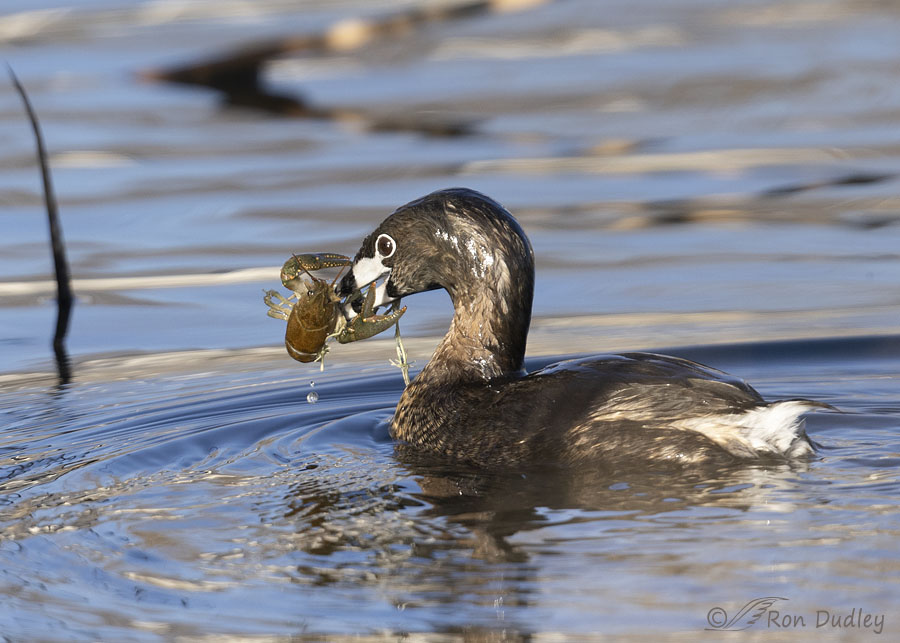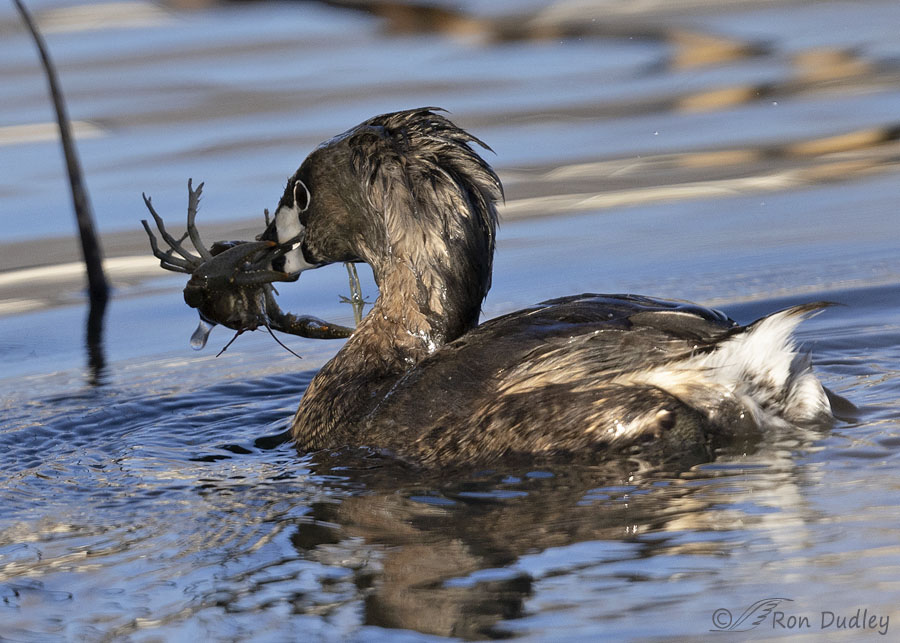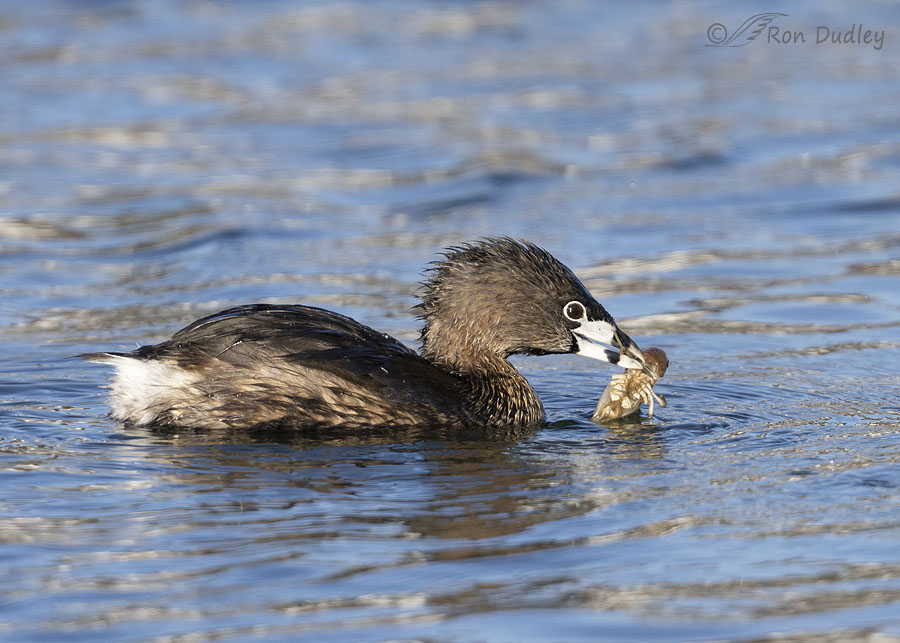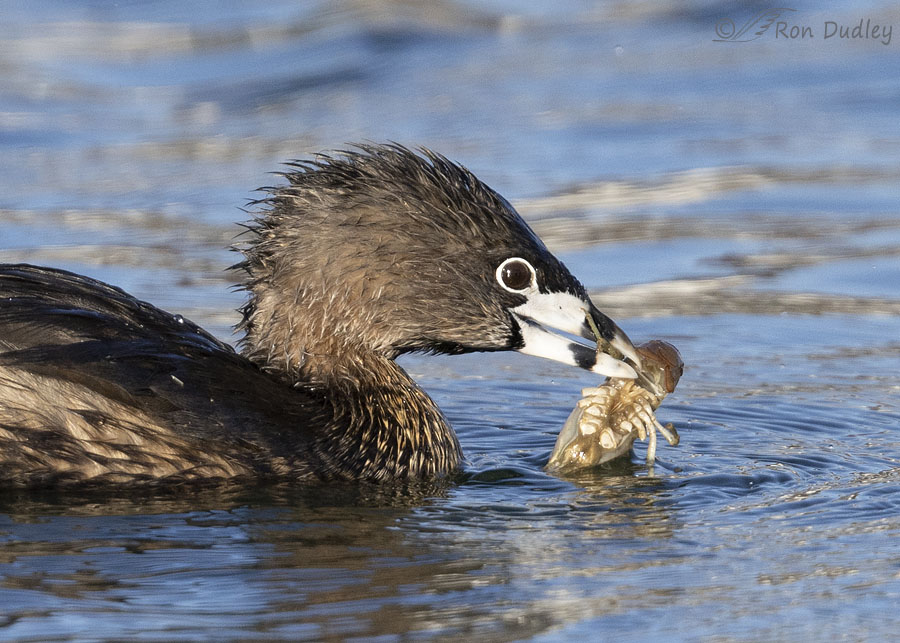At least when it comes to crayfish (crawdads).
In my experience most birds that prey on crayfish swallow them whole but Pied-billed Grebes are an exception. Crayfish have 4 pairs of walking legs (the two anterior pair have small terminal pincers) and I pair of anterior appendages that have large terminal pincers (chelipeds) and all ten appendages stick out from the body. These grebes are just the right (wrong) size relative to the size of the crayfish to make swallowing them whole next to impossible when the appendages are still attached.
Additionally, during the swallowing process the pincers could be dangerous, especially to the grebe’s eyes.
So Pied-billed Grebes amputate the appendages before swallowing the rest of the crayfish. I find it to be a completely reliable behavior.

1/2500, f/5.6, ISO 640, Canon R5, Canon EF500mm f/4L IS II USM + 1.4 tc, not baited, set up or called in
Last week at a local pond this adult Pied-billed Grebe caught a crayfish and immediately swam back to the relative safety of some nearby reeds to give ‘him’ some cover from thieving gulls while he performed his meal prep. In this photo we can see most of the appendages of the crayfish well enough to confirm that they’re still intact.

1/2500, f/5.6, ISO 640, Canon R5, Canon EF500mm f/4L IS II USM + 1.4 tc, not baited, set up or called in
Here the grebe is grasping the upside-down crayfish by its tail. We can clearly see the four walking legs on the left side of the crayfish and the right cheliped. The left cheliped is in front of the crayfish and kind of hard to see but it’s there.
At this point the grebe turned uncooperative. He performed most of the amputations with his head underwater and with his back to me.

1/3200, f/5.6, ISO 640, Canon R5, Canon EF500mm f/4L IS II USM + 1.4 tc, not baited, set up or called in
But less than ten seconds later the results were obvious.

All ten appendages had been completely or partially amputated. In this photo, if the chelipeds (large pincers) were still attached they might still be underwater but I could tell from other photos that they’d been removed too.
And of course, he turned his back to me while he was swallowing his fully prepped meal but it went down slick as a whistle.
I don’t recall ever seeing a Pied-billed Grebe swallow an adult crayfish without performing these amputations first. I suspect that if the crayfish is tiny they swallow them whole but that’s something I don’t believe I’ve ever documented.
Ron


Well, Ron I don’t know how I missed this post on the Pied-billed Grebe. I love these little birds. A series of photos were taken by one of the photographers at Green Cay Wetlands you would have enjoyed. A parent was in the process of teaching one of it’s little ones how to dive to find food. It was so special.
With the cold rains we’re having right now, a crawfish boil (or any kind of boil) sounds really good!
That grebe does a better job without hands than I do with a knife! Also, it looks like that was a beautiful day to be out with a camera, chocolate donut, and some birds.
Marty, there were no chocolate donuts on that day. I only eat them on long morning bird trips but this pond is just a short jaunt from my house.
Do they go back and eat the claws/legs later? As Arwen says, there’s meat in them. Maybe no, per Judy’s comment, too much roughage? (although the bodies have a lot, too?) But they sure do look like they’ve been shorn off with a cleaver!
“Do they go back and eat the claws/legs later?”
Nope, I’ve never seen it happen Carolyn. Not once and I’ve watched for it. There would be very little “meat” in the walking legs but I’ve never seen them retrieve the meatier chelipeds either.
Well, glad I’m not a grebe, I’m no good with knives, can’t imagine the damage I’d do if I had to hold my meal in my mouth and violently shake my head to make it more palatable. Great photos and lesson today, Dr. Dudley!
Great photos and lesson today, Dr. Dudley!
“I’m no good with knives”
Chris, you may remember that several years ago I cut off the end of one of my fingers with a butcher knife. So…. ditto.
https://www.featheredphotography.com/blog/2018/07/29/some-good-news-on-my-finger-injury-plus-a-dose-of-critter-cuteness/
I just went back to look at that 7/29/18 post and a couple from before and after, and see that I commented on posts both before and after, but not ON that one, probably because the view of the “trimmed” finger was too much for me to handle! Probably could have lived without seeing it this time, too! LOL.
LOL.
It ain’t purdy, that’s for sure.
Like you, I’ve seen many Pied-billed Grebes come to the surface with a crayfish in its beak. But I agree, I have never seen a crayfish go down a grebe’s gullet with its appendages intact. A violent and quick shake does a good job of sending those pincers flying. I have single photos but not a nice series like this. I once saw a Double-crested Cormorant wait until a grebe did this shake and then move in to attempt to steal it. The grebe was too fast, diving and resurfacing a long distance away still holding its catch before swallowing it. The cormorant went back to catching bullhead which strikes me as just as hard to swallow. Those stiff, sharp spines on the pectoral fins must be hard going down but they manage without beating their prey on a branch as a kingfisher does. Great series.
” I have never seen a crayfish go down a grebe’s gullet with its appendages intact”
Good to know that your observations are the same as mine, Dan. I’m always a little insecure about making claims like that for fear that what I report might not be accurate for some reason.
Now we know the inspiration for the saying “I’m going to tear you from limb to limb to limb to limb….
Terrific closeups, by the way.
Thanks, Lyle.
Love it. Keep up the bird biology information. More to life than just photos and names.
I will, Dave.
Crawfish just make me hungry. And the claws have meat, silly grebe
I meant to add…but I get the punching! I wouldn’t eat the live ones.
Arwen, they make a lot of folks hungry. Personally, I’ve never eaten them.
Did not know that. Another early morning lesson. Thanks Ron.
You’re welcome, Michael.
Smart Grebe(s)! Besides the danger the pincers pose I imagine they don’t need the extra “roughage” Interesting that he chose to perform the amputations under water. Perhaps the water provides some “support” for his meal?
Interesting that he chose to perform the amputations under water. Perhaps the water provides some “support” for his meal?
-21 this morning……. +21 for a high and a proper chinook starting early tomorrow morning. I’m ready even if the roads will get ugly for awhile…
“Perhaps the water provides some “support” for his meal”
Judy, I imagine the water provides resistance for when he shakes the crayfish underwater, which removes the appendage. I’ve seen them do it when they perform the amputation on top of the water. They do it both ways.
Was wondering how they could get them off. Must be strong head shaking!
It is, Catherine. Strong and fast.